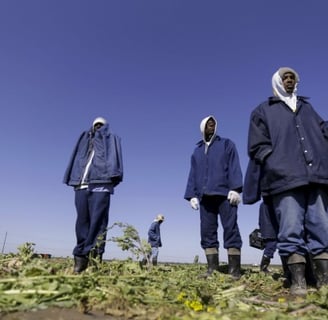The Hidden Labor Behind Your Plate: U.S. Prisoners in the Food Industry
A recent investigation by The Associated Press has shed light on a little-known aspect of the U.S. food industry: the widespread use of prison labor in food production. This practice, deeply rooted in American history, raises significant ethical and economic questions about the role of incarcerated individuals in our food supply chain
Felipe Saint-Martin
7/19/20242 min read


A recent investigation by The Associated Press has shed light on a little-known aspect of the U.S. food industry: the widespread use of prison labor in food production. This practice, deeply rooted in American history, raises significant ethical and economic questions about the role of incarcerated individuals in our food supply chain.
The scale of prison labor in food production is substantial. The AP investigation uncovered hundreds of millions of dollars worth of transactions tied to agriculture-based prison labor over the past six years. This labor touches a wide array of products, from staples like beef, soybeans, corn, and wheat to processed foods and even popular brands like Frosted Flakes cereal and Coca-Cola.
The historical context of this practice traces back to the post-Civil War era. The 13th Amendment, while abolishing slavery, included an exception for involuntary servitude as punishment for crime. This loophole allowed Southern states to maintain a cheap labor force through convict leasing systems, a practice that has evolved into today's prison labor programs.
Currently, incarcerated workers face challenging conditions. They often work for minimal wages, sometimes as low as 10 cents per hour, and lack basic worker protections. Many are compelled to work under threat of punishment, including solitary confinement or loss of privileges. Despite these conditions, prison labor is deeply embedded in the supply chains of major food companies and brands.
The debate surrounding prison labor in the food industry is complex. Proponents argue that it provides valuable skills and reduces recidivism rates. Critics, however, point to the exploitative nature of the system and its disproportionate impact on people of color. The practice also raises concerns about its effect on the broader labor market and food prices.
In response to these issues, there are growing calls for reform and transparency. Efforts are underway to amend the 13th Amendment to remove the exception clause. Advocates are pushing for fair wages, improved working conditions, and greater transparency in supply chains.
The use of prison labor in the U.S. food industry is a multifaceted issue that demands attention. As consumers, we often remain unaware of the hidden labor behind the food on our plates. This lack of transparency underscores the need for greater awareness and potential policy changes to address the ethical and economic implications of this practice.
As we move forward, it's crucial to consider how we can balance the rehabilitation of incarcerated individuals with fair labor practices and the integrity of our food system. The recent revelations about prison labor in food production offer an opportunity for meaningful dialogue and reform, ensuring that our food choices align with our values of justice and equity.
From farm to fork, freedom to fairness: It's time we digest the true cost of our food.
